Since 1984, Apple has made some strange Macintosh computers. How many have you used?
Forty years ago today, Apple released the first Macintosh. Since that fateful day in 1984, Apple has released hundreds of Mac models that run the gamut from amazing to strange. In honor of this birthday, we thought it would be fun to comb through history and pull out the rarest and most unusual production Mac models ever made—including one from another company.
Each machine listed below was manufactured and sold to the public—no prototypes here. These computers highlight not only Apple's innovative spirit but also its willingness to take risks and experiment with design and functionality. It's worth noting that what is "weird" in this case is a matter of opinion, so you might have your own personal picks that we missed. If that's the case, let us know in the comments. And we'd love to hear what the Macintosh means to you on this 40th anniversary.
Special thanks to Jonathan Zufi for providing several photos for this article. In 2014, Zufi created an excellent coffee table book called Iconic: A Photographic Tribute to Apple Innovation and formerly ran the Shrine of Apple website.
Macintosh XL (1985)

The Macintosh XL was a jumbo-sized Mac based on the Lisa 2.
Apple
In the pantheon of Macintosh, there are odd ducks, then there is the Macintosh XL. It's officially a Mac, but it started life as its predecessor, the Apple Lisa 2. The Lisa line predated the Macintosh by one year, launching in 1983 for a pricey $9,995 ( about $31,348 today, adjusted), and it received a single revision in 1984. Macintosh dramatically undercut the Lisa in price and could run similar applications, so Apple was stuck with large amounts of unsold Lisa units.
When the Macintosh XL debuted in January 1985 as part of the Macintosh Office launch, it served as a clever way to clear out unsold Lisa 2 inventory. The plan was simple: bundle the Lisa 2 hardware with MacWorks XL—a program that let the Lisa run Macintosh software— and shoehorn it into the Macintosh line. (A curious tidbit: Lisas running MacWorks XL originally inspired the term "hackintosh.")
Even being a "hackintosh," the XL was no slouch. At a time when the most powerful Macintosh sported only 512KB of RAM, no hard drive, and a 9-inch display, the Macintosh XL (probably for "extra large") featured a 12-inch monitor and could use up to 2MB of RAM and a 10MB internal hard disk. Interestingly, customers bought out the entire $3,995 Macintosh XL run within five months of its release, and even though customers were hungry for more, Apple had no intention of manufacturing any more Lisa-like machines. The XL met its end in June 1985.
Macintosh Portable (1989)
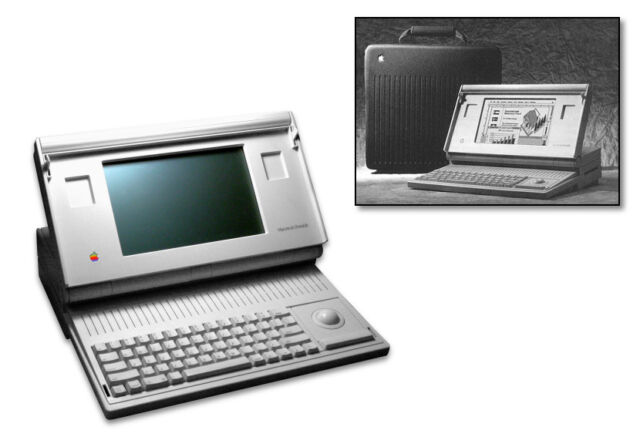
The Macintosh Portable was Apple's first battery-powered portable Mac.
Benj Edwards, Apple
One could easily say that the original 1984 Macintosh was portable. It was compact, it included a built-in carrying handle, and it incorporated a CPU, disk drive, and monitor in one unit. In fact, shoulder-strap carrying bags were popular accessories for the original compact Mac. But they had one major drawback that limited their portability: They needed access to a power outlet to work.
Enter the Macintosh Portable in 1989. By that point, Apple had expanded the Mac range to include powerful desktop machines, some modular, like the Mac II series. But for the Portable, Apple stuck with a configuration very similar to the Mac Plus: a 16 MHz 68000 CPU and 1 megabyte of RAM. Unlike the Plus, however, the Macintosh Portable was a battery-powered clamshell machine (about eight hours of battery life) with a 640×400 monochrome active matrix LCD display (non-backlit, although a backlit model arrived briefly in 1991).
Today, the Macintosh Portable is rare because it originally sold for $6,500 to $7,300 ($15,950 to $17,913 in today's dollars), and it didn't sell as well as Apple hoped. Drawbacks included a large size and 16-pound weight. But it featured an impressive modular design with upgradable memory and modem slots, plus the ability to position the trackball on the left or right side of the keyboard. And if you were feeling financial, you could even swap out the trackball for an optional numeric keypad. (Cool trivia: The Portable sports hidden developer signatures molded inside its case.)
JLPGA PowerBook 170 (1992)
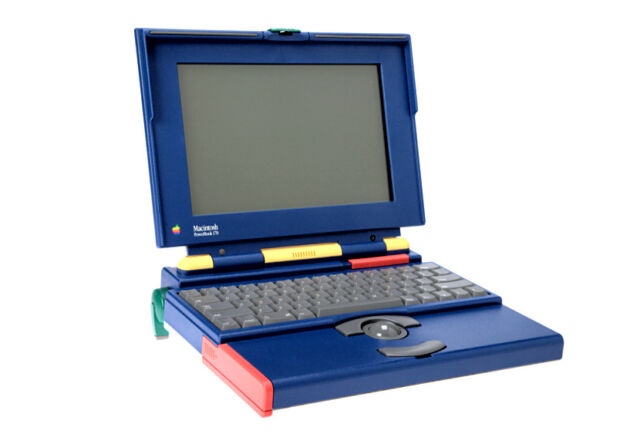
The JLPGA PowerBook 170 has colorful flare.
Jonathan Zufi
By itself, the PowerBook 170 was a capable and fairly popular Mac laptop—it included a 25 MHz 68030 processor and a 10-inch monochrome active matrix display. Its eye-watering retail price of $4,600 in 1991 (about $10,269 today) will make you thankful for modern MacBook Air prices. But it was entirely gray, like other PowerBooks of the era. Boring!
Thankfully for Japanese fans of colorful Macs with deep pockets, Apple produced a limited edition of 500 PowerBook 170s with an array of bright colors to commemorate the 1992 Japanese Ladies Professional Golf Association (JLPGA) tournament in Japan. The JLPGA PowerBook 170 includes a mostly blue body with a red battery door, a yellow hinge, and green adjustable feet. Otherwise, it seems identical to a typical PowerBook 170.
Due to its limited production run, the JLPGA PowerBook 170 is one of the rarest Macs on this list, and it regularly sells among collectors for several thousand dollars. Oddly, if you bought one of these today, considering its extreme original retail price, you'd still be getting a bargain.
Macintosh Color Classic II (1993)

The Macintosh Color Classic II (right) and its box (left).
Jonathan Zufi
The first Macintosh Color Classic brought a color display to the compact Mac series for the first time in 1993 (color displays first came to modular desktop Macs in 1987). It included a 16 MHz Motorola 68030 CPU and a built-in Sony Trinitron CRT showing a 512×384 resolution. In many ways, it seemed like the Mac everyone had wanted since 1984, but due to software in use by 1993 and a forced 16-bit data bus, it felt underpowered. Also, many color Mac games were designed for a higher resolution (like 640×480).
Later in 1993 (October, to be precise), Apple released the Color Classic II (also known as the Performa 275 in some markets), which had a much faster 33 Mhz 68030 CPU. It could use up to 36MB of RAM, and like the original Color Classic, it could use PDS slot cards like the Apple IIe Card. On its Color Classic II page, Low End Mac writes, "This is what the Color Classic should have been."
Despite being one of the pinnacles of the compact Mac series (along with, say, the Mac SE/30), the Color Classic II is very rare today because it only sold limited numbers in Canada, Europe, Asia, and Australia—it was never released in the United States. If you run across one with its original box, you're looking at a rare find indeed.
Macintosh TV (1993)
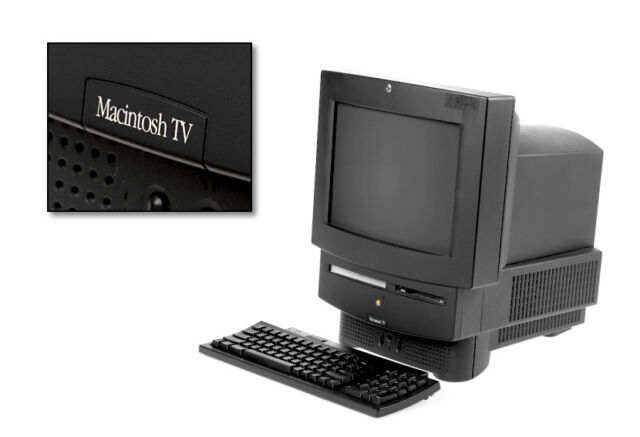
The Macintosh TV would fit right in at Darth Vader's castle.
Jonathan Zufi
At a time when almost every Macintosh was a variation of beige or gray, the Macintosh TV came along with a splash of black (a smudge?) to spice things up a bit. While the Macintosh TV shipped in a plastic case with the same mold as the LC 500 series, the black color helped differentiate it as a different beast entirely: part computer, part TV set.
Yes, the Macintosh TV was a computer and a television receiver: You could plug in your cable TV line or hook up an antenna to the back and watch television on the monitor. Low End Mac called it "perhaps the oddest Macintosh ever." That's because it was "the last desktop Mac with a 68030 processor, the first with a built-in TV tuner, the first black desktop Mac, and the first Mac to ship with a remote control."
It had other oddities: an intentionally limited data bus (for market segmentation), no upgrade slots, and a maximum of 8MB of RAM. Even with TV integration, users couldn't watch TV and use the computer at the same time—although the machine let you snap still images of the video feed. With only a four-month life span and 10,000 units sold, it's one of the rarest production Macs ever made.
PowerBook 550c (1995)
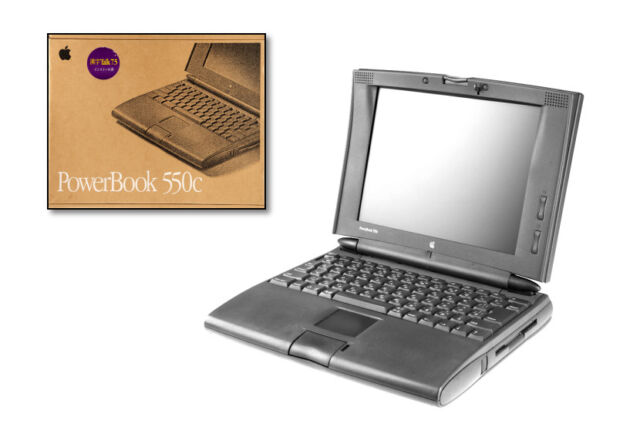
The PowerBook 550c (right, with box on the left) was only sold in Japan.
Jonathan Zufi
Just a year after Apple released the PowerBook 540c, the company released the all-black PowerBook 550c—but only in Japan. It featured a 33 MHz 68040 CPU, 500MB hard drive, 8MB of RAM, and a color 10.4-inch active matrix LCD. Other than the color and some bumped specs, the 550c is most notable for being very rare.
The 500 series had a cool feature using an extra swappable bay that could house a spare battery, a PCMCIA module, or an FPU to supplement the 68LC040 CPU in some models, although the 550c included an FPU built-in.
If you're a fan of black vintage Macs, you can complete the perfect trifecta (alongside the Macintosh TV and PowerBook 550c) with the Performa 5440, sold only in Asia and Europe. These days, black Macs are popular with collectors, but why they didn't ship more of them in the United States is a mystery.
Pioneer Multimedia Personal Computer MPC-GX1 (1995)
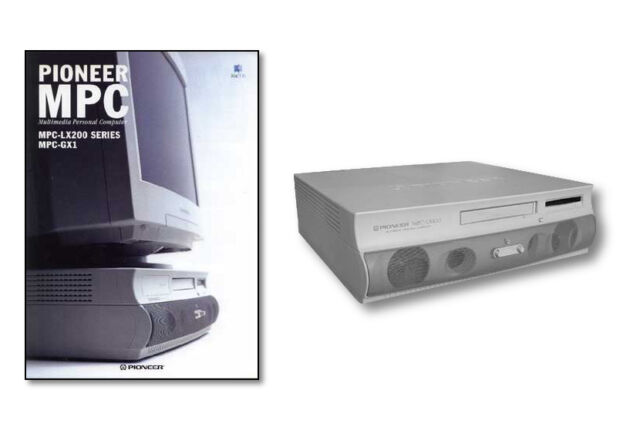
The Pioneer Multimedia Personal Computer MPC-GX1 was a licensed Mac clone sold only in Japan.
Pioneer
Taking a page from PC clones, Apple allowed other companies like Power Computing, Motorola, and UMAX to sell PowerPC Mac clones between 1995 and 1998. Apple wanted to grow market share for the Mac platform, and the licensing program for Mac OS 7 and its supporting architecture generated quick cash for Apple during a rough time in its financial history.
Of these clones, some of the most interesting emerged in Japan. In 1995, Pioneer released a series of machines branded "Multimedia Personal Computer," with MPC-GX1 first in the series. The MPC-GX1 included a 66 MHz PowerPC 601 CPU, a 500MB hard drive, and 16MB of RAM—nothing too special there. Where it deviated from the typical Mac was its inclusion of built-in high-fidelity multi-directional speakers in a stylish, wavy case. It also came with a subwoofer for better sound and included an integrated CD-ROM drive for more multimedia muscle.
To up the multimedia ante, later entries in the Pioneer MPC series included a TV tuner card (the MPC-LX200-TV) and a 640MB Magneto optical drive (the MPC-LX200-MO). Pioneer left the Mac clone market in October 1997, and these units never sold in the US, making them fairly rare today.
Twentieth Anniversary Macintosh (1997)

The Twentieth Anniversary Macintosh was the first desktop Mac with a built-in LCD screen.
Apple
Steve Wozniak, Steve Jobs, and Ronald Wayne founded Apple in 1976. Twenty years later, Apple executives created a special Macintosh to celebrate the anniversary. Developing the computer took time, of course, so the resulting Twentieth Anniversary Macintosh actually came out nearly 21 years after the original creation of Apple itself (but, to be fair, about 20 years after its incorporation in 1977).
In a design that somewhat presaged today's flatscreen iMacs, this futuristic all-in-one machine included a 250 MHz PowerPC 603ev CPU, a 12.1-inch active matrix LCD that ran at 800×600 resolution, a vertically mounted CD-ROM drive, a floppy drive, and a 2GB hard drive. To show its multimedia cred, it also included video capture hardware, a TV tuner, and a custom Bose sound system with a modular subwoofer. It used a number of PowerBook laptop parts, including a keyboard with a touchpad.
Apple launched the TAM at $7,499 (about $14,376 today) as a luxury machine, with fewer than 12,000 units produced. If you bought one, Apple reportedly hand-delivered it to you with a concierge service. The price dropped dramatically a year later, before it was discontinued. It's still considered a rare luxury among collectors to own one today.
Power Macintosh G3 All-In-One (1998)
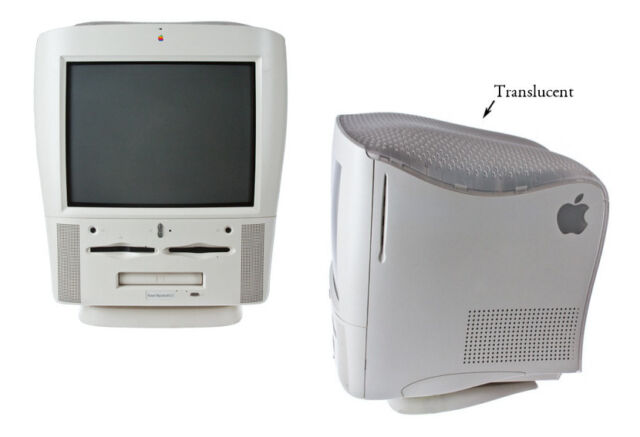
The G3 All-in-One is often nicknamed the "Molar Mac."
Jonathan Zufi
Just two months before Apple unveiled the original iMac—the sleek, minimal machine that remade Apple's fortunes—the very same company released the Power Macintosh G3 All-In-One (often nicknamed the "Molar Mac" due to its tooth-like shape). Given only the specs—a 233 or 266 MHz PowerPC G3 CPU, a built-in 15-inch monitor, 4GB hard drive, and 24X CD-ROM drive—you might think the G3 AIO is a type of iMac, but those numbers are where the similarity begins and ends.
In fact, the All-In-One was the polar opposite of the iMac: While the iMac made waves for ditching features like floppy drives and legacy ports, the G3 AIO was a kitchen sink computer (it's right there in the name!), including plenty of legacy ports, three internal PCI slots, a built-in CD-ROM, a floppy drive, and even an Iomega Zip Drive option. Whereas the iMac was relatively small and minimal (and came with a built-in carrying handle), the G3 AIO was a tall, bulky (nearly 60 lbs.), and top-heavy beast.
Interestingly, the G3 AIO included some translucent plastics on its top plate during a time when Apple was flirting with translucent plastic accents in its industrial design, revealing a hint of what would come with the iMac. But unlike the iMac, the G3 AIO was not a wildly successful mass-market machine: it was available only to the education market in North America, making it a relatively rare computer today.
Power Macintosh G4 Cube (2000)
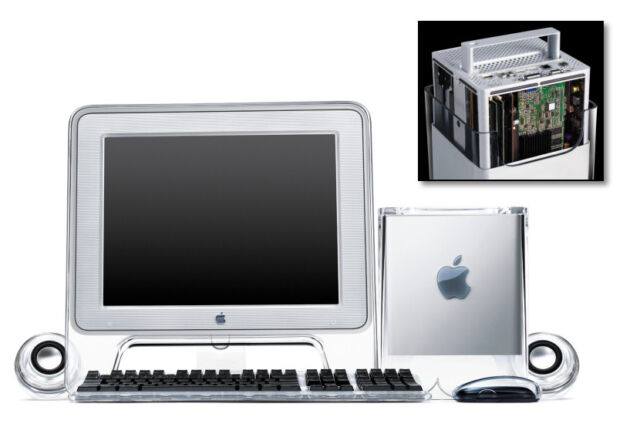
The Power Macintosh G3 Cube was a beautiful flop.
Apple
Steve Jobs apparently liked cubes, and it showed. First he launched the Pixar Image Computer in 1986, then the NeXT Computer in 1988. So perhaps it's no surprise that in 2000, Jobs unveiled the Power Macintosh G4 Cube—an 8x8x8-inch metal cube suspended in acrylic, featuring a 450 MHz PowerPC G4 processor, 64MB of RAM, a 20GB hard drive, a DVD-ROM drive, and a 56 kbps modem. Notably, it lacked an internal fan, making for quiet operation.
The Cube was one of those rare computers that many seemed to envy and admire from afar but few people bought. The G4 Cube came at an awkward time for Apple: just before mainstream OS X, before the iPod, before commonly available broadband Internet, and before easy wireless peripherals and Wi-Fi. It was saddled with cord-management problems and perceived aesthetic flaws in its clear acrylic case that briefly caused a media fracas.
The Cube's relatively high price ($1,799, or about $3,193 today) compared to the similarly equipped Power Mac G4 and its lack of expandability led to disappointing sales (only about 41,000 units). It was discontinued a year later. The G4 Cube has since become a rare and coveted collector's item, celebrated for its unique design and symbolizing Apple's design-focused philosophy. In many ways, it was ahead of its time.
Flower Power and Blue Dalmatian iMacs (2001)

Dalmatian (left) and Flower Power (right) iMacs added fun splashes of color to the G3 iMac line.
Apple
Bondi Blue, Blueberry, Strawberry, Lime, Tangerine, Grape, Graphite, Indigo, Ruby, Sage, and Snow. Remember these names, for they will live in legend.
Just kidding—until early 2001, those were the solid colors of G3 iMacs that Apple had shipped up to that point. In February of that year, Apple branched out in a wild new direction and released the first and only G3 iMacs that featured patterns molded directly into the plastics: Blue Dalmatian and Flower Power. At the time, Steve Jobs said that manufacturing the designs took 18 months to perfect.
Blue Dalmatian features white dots on a blue background, and Flower Power flaunts a psychedelic multi-color flower pattern. Equipped with a 500 MHz PowerPC G3 processor, these iMacs were technically similar to their contemporaries but stood out due to their unconventional appearance. While they received mixed reactions for their designs, these iMacs marked a period where Apple was willing to experiment boldly with computer aesthetics. Since they weren't very popular at the time, relatively few sold, and they're fairly rare today.
Mac Pro (Late 2013)
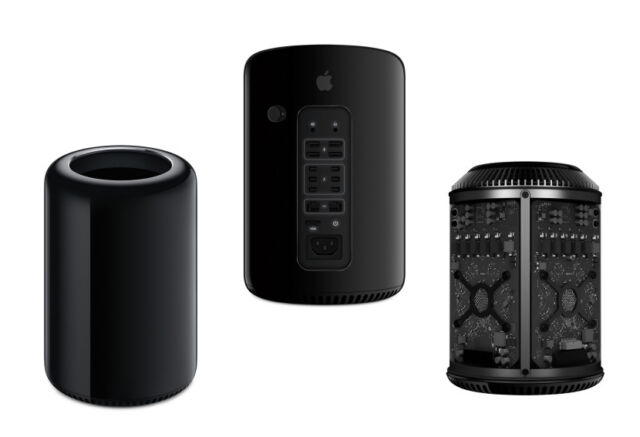
The Mac Pro (Late 2013) from the front (left), the back (center), and without its lid (right).
Apple
Dubbed the "trashcan" due to its cylindrical design with a hole in the top for ventilation, the Late 2013 Mac Pro represented a significant departure from traditional desktop form factors. At the time, critics complained that Apple produced uninspiring hardware that had not surprised or delighted since Jobs died two years earlier. During the Mac Pro's unveiling at the 2013 WWDC keynote, Phil Schiller famously said, "Can't innovate anymore, my ass."
The new Mac Pro was powerful—initially featuring quad-core or six-core Xeon GPUs and twin AMD FirePro GPUs—but its compact, sleek form got in the way of function. The new Mac Pro eschewed internal PCIe upgrade slots for six Thunderbolt and four USB 3 ports, relying on external expansion. Much of its internal space was devoted to a unique triangular "thermal core" for heat dissipation.
In 2017, Apple admitted failure with the design and said it was "completely rethinking" the Mac Pro, but the replacement didn't arrive until 2019. In the meantime, the cylindrical Mac Pro set a record for the longest fundamentally unchanged Mac model (barring CPU bumps and the like), remaining on sale for 2,182 days.
Even when the new Mac Pro released in 2019, Apple didn't abandon its circular ambitions entirely. As an option, Apple sold a set of $400 Mac Pro wheels, carrying on the proud tradition of creating a Mac Pro that can literally roll away.
Happy birthday, Macintosh!
Source




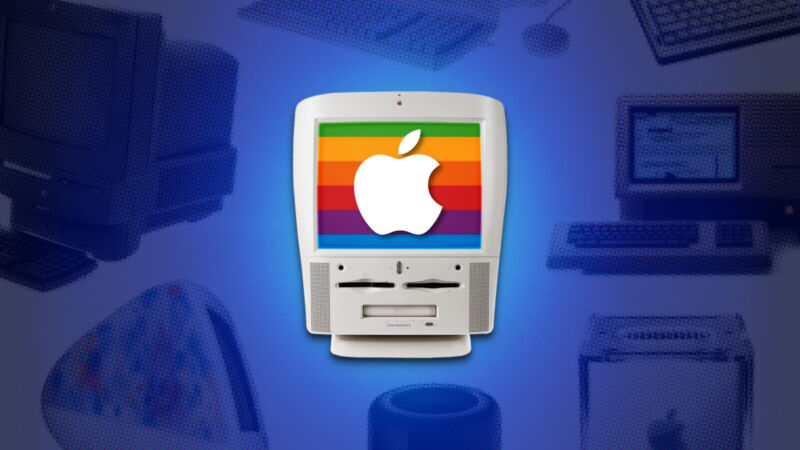
3175x175(CURRENT).thumb.jpg.b05acc060982b36f5891ba728e6d953c.jpg)










Recommended Comments
There are no comments to display.
Join the conversation
You can post now and register later. If you have an account, sign in now to post with your account.
Note: Your post will require moderator approval before it will be visible.